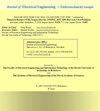QCA电路的能量估计:多路复用器的研究
IF 1.2
4区 工程技术
Q4 ENGINEERING, ELECTRICAL & ELECTRONIC
Journal of Electrical Engineering-elektrotechnicky Casopis
Pub Date : 2022-08-01
DOI:10.2478/jee-2022-0036
引用次数: 3
摘要
量子点元胞自动机(Quantum-dot Cellular Automata, QCA)是互补金属氧化物半导体(CMOS)技术的竞争对手,也是最尖端的纳米级技术之一。多路复用器是纳米通信和纳米计算领域的重要组成部分。本文的研究项目是QCA多路复用器,并选择了少数最好的多路复用器作为本实验的样本。在qcaddesigner -2.0.3仿真引擎环境下设计了QCA布局,并在8个样本上成功实验,获得了最佳布局。利用qcaddesigner - e (QDE)对基于坐标的能量进行估算,并利用QCAPro对非绝热能量浪费进行研究。根据基于坐标的技术,最佳节能QCA复用器的总能量浪费为5.90 meV,每周期平均能量损失为0.537 meV。另一种基于qcapro的方法用于估算恒温下三种不同层次隧道的能量损失,对节能多路复用器产生约12至15 meV的总能量损失。本文章由计算机程序翻译,如有差异,请以英文原文为准。
Energy estimation of QCA circuits: An investigation with multiplexers
Abstract Quantum-dot Cellular Automata (QCA) is a rival to complementary-metal-oxide-semiconductor (CMOS)-based technology and one of the most cutting-edge nano-scale technologies. The multiplexer is a fundamental component in the fields of nano communication and nano computation. The investigative item of this article is the QCA multiplexer, and a handful of the best multiplexers were chosen as samples for the current experiment. The QCA layouts were designed in the QCADesigner-2.0.3 simulation engine environment, and the best one was reported after successfully experimenting on a total of eight samples. The co-ordinate-based energy was estimated using QCADesigner-E (QDE), and the non-adiabatic energy waste was investigated using QCAPro. According to the coordinates-based technique, the overall energy waste of the best energy-saving QCA multiplexer is 5.90 meV, with an average energy loss per cycle of 0.537 meV. Another approach, QCAPro-based, was used to estimate the energy loss at three different levels of tunneling at a constant temperature, yielding an overall energy loss of approximately 12 to 15 meV for the energy-efficient multiplexers..
求助全文
通过发布文献求助,成功后即可免费获取论文全文。
去求助
来源期刊
CiteScore
1.70
自引率
12.50%
发文量
40
审稿时长
6-12 weeks
期刊介绍:
The joint publication of the Slovak University of Technology, Faculty of Electrical Engineering and Information Technology, and of the Slovak Academy of Sciences, Institute of Electrical Engineering, is a wide-scope journal published bimonthly and comprising.
-Automation and Control-
Computer Engineering-
Electronics and Microelectronics-
Electro-physics and Electromagnetism-
Material Science-
Measurement and Metrology-
Power Engineering and Energy Conversion-
Signal Processing and Telecommunications

 求助内容:
求助内容: 应助结果提醒方式:
应助结果提醒方式:


